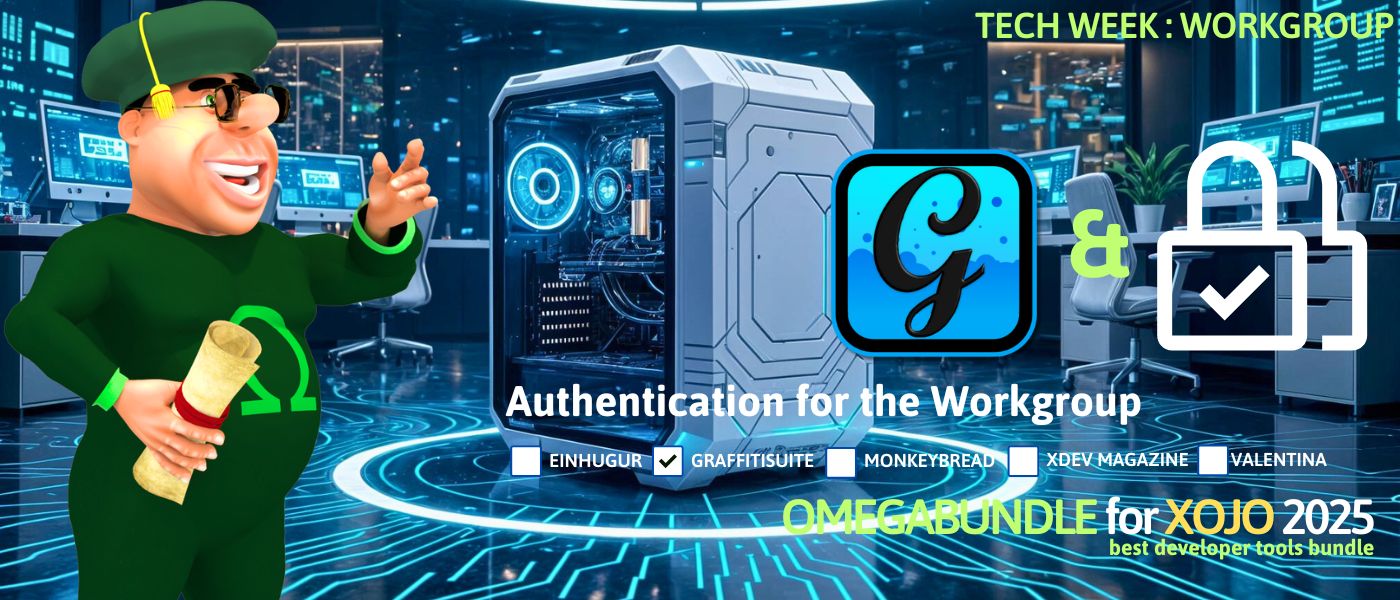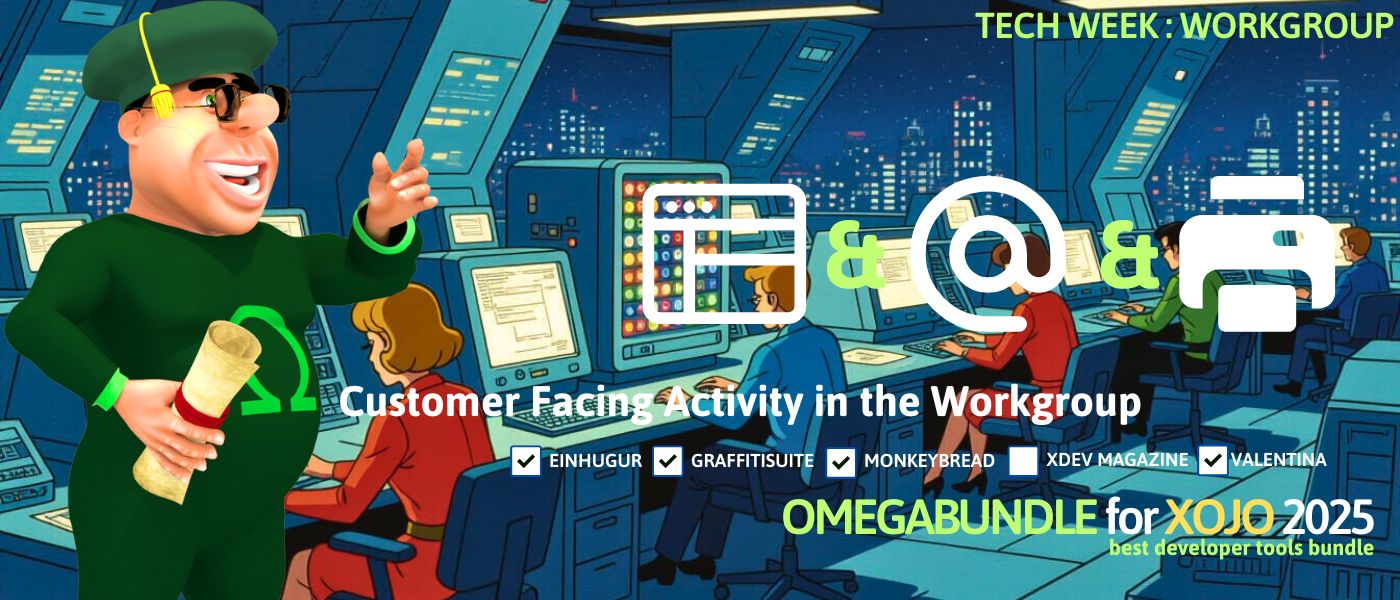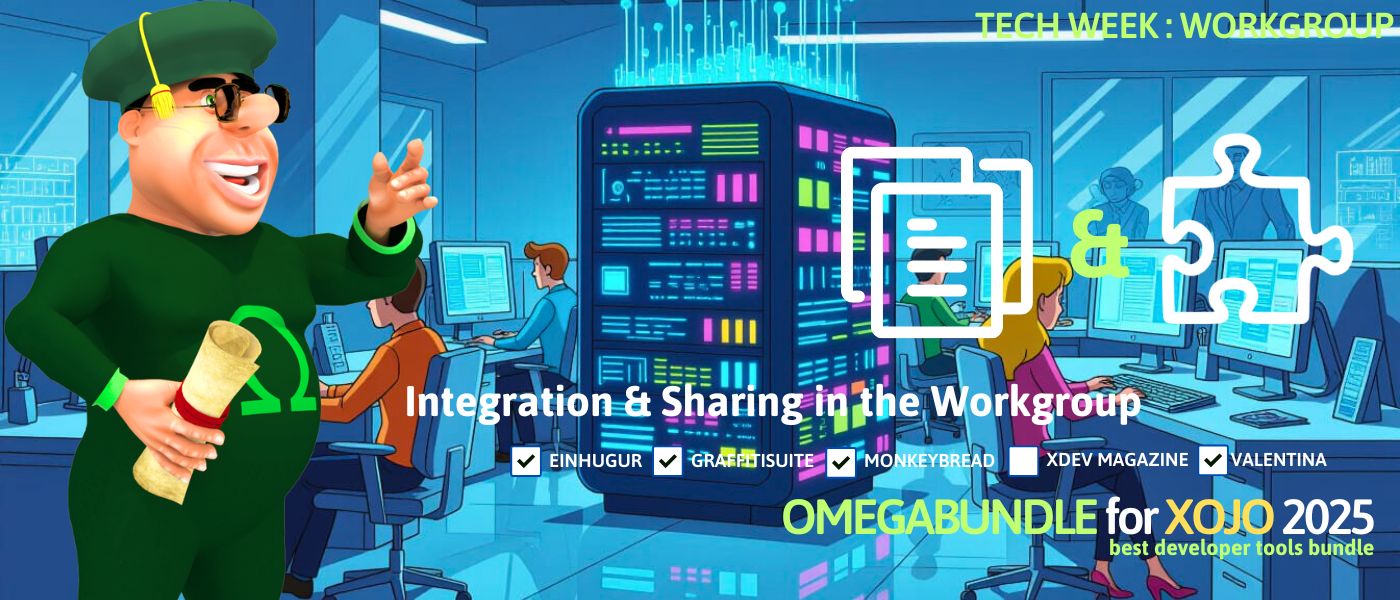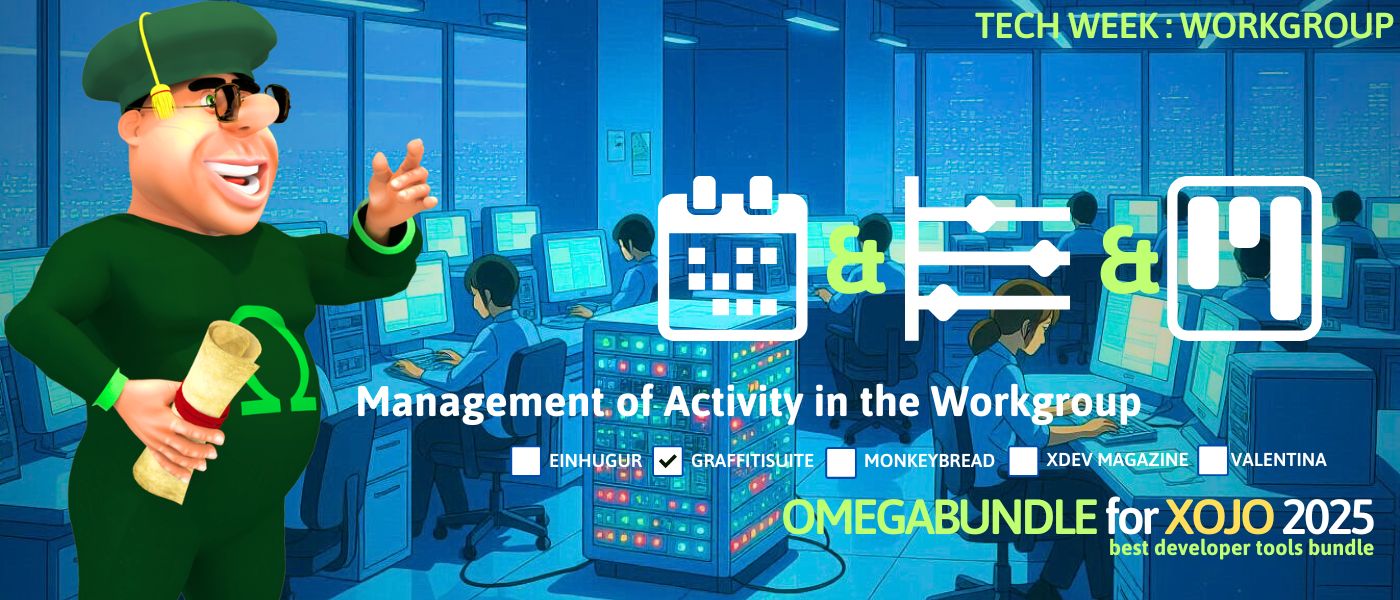What are some considerations in building workgroup solutions using Xojo?
Xojo provides an excellent platform for building workgroup solutions for small-to-medium sized business. It is unlikely that your potential or present client is an expert in the different ways you can implement workgroup solutions and how one type of implementation comes with certain constraints and limitations than others. That is an added value of having an expert help advise them on implementations that will satisfy their needs for productivity particular to their business. Going into Tech Week 2025: Xojo + Workgroup, we will make a few assumptions.
- The system needs some form of user authentication
- The system needs some form of secure, centralized data store that can import, export and utilize the data for business purposes
- The system does not lock them in to an expensive, difficult to maintain solution
There are also other considerations, especially once you drill down into industry specific requirements. Let's look at considerations for building client-server workgroup solutions with Xojo.

Client Authentication
All businesses are likely to have employees that come and go and so require granular, secure access to the system. It should not be a hard sell to convince a client that two factor authentication is the way to go. Fortunately, GraffitiSuite Desktop provides a solution.
GraffitiSuite Desktop includes GraffitiTOTPField and the GraffitiTOTPProvider class for time-based one time password value display or entry, complete with auto-progression and display of validation status.
These classes together implement two factor authentication. The application uses TOTPProvider to generate a Time-based One Time Passcode (TOTP). The end user 2FA Authentication app does the same. TOTPField is an entry control for this six digit code, which is then compared to the one generated for validation. Your client application submits the value to a server for validation during the login process. A server isn’t required. It could be entirely implemented client-side, but client-server is the typical integration. You can implement some sort of authorized login state (this is typically no more than 30 days) wherein the user does not need to re-validate their login and TOTP.
Versions of both classes are available for Xojo Web as well (sold separately) if you later need to expand to support web client access.
Integration & Workgroup Sharing
No matter how vertical a market you serve, integration with system and common business tools remains important. For example, small to medium sized dental offices remain a popular vertical market with Filemaker solution developers, but Claris Corporation (a subsidary of Apple, Inc) supports integration with Microsoft Excel. A new platform that offers little or no integration with other common industry specific applications or operating system features has an almost insurmountable barrier to success.
Xojo supports integration with special operating system features right out of the box, but several Omegabundle for Xojo products expand the range of the types of sharing and integration.
Office Related Integration
- Einhugur Excel Plugins for Xojo. Including ExcelWriter plugin and Excel Reader plugins
- Einhugur Word Plugin for Xojo. Word plugin is a Xojo plugin that enables you to create, read, write and edit Word docx files from Xojo code
- Einhugur OpenDocument Plugin for Xojo. Create, read, write and edit OpenDocument Text files (.odt) from your Xojo code
PDF Related Integration
Xojo supports PDF generation right out of the box, but lacks a number of features that you don't want to learn as a surprise later. One example of this is font handling when dealing with international character sets.
- Einhugur PDF Plugin for Xojo. Xojo plugin to generate PDF documents
- MBS DynaPDF Starter Edition Plugin for Xojo. Feature rich Xojo plugin to generate PDF documents
- GraffitiHTMLtoPDF Plugin for Xojo. Takes your arbitrary HTML and output a rasterized PDF
- Valentina Reports ADK Export to PDF. Full reporting system can export Reports to PDF, both in the ADK and in Valentina Developer Network Server.
macOS Related Integration
If your client has a mixed or Apple only workplace (iOS devices, macOS computers, etc), chances are good they will want to leverage features that are a part of the operating system.
- Einhugur macOS Bridge Plugin for Xojo. Use some macOS Native objects and interface with them using Xojo objects, Einhugur Plugin objects such as RawBitmap, declares and 3rd party plugins
- Einhugur Vision Bridge Plugin for Xojo. Make use of Apple Vision framework in your Xojo applications
Linux Related Integration
- Einhugur Linux Bridge Plugin for Xojo. Use some Gtk Native objects and interface with them using Xojo objects, declares and 3rd party plugins
Windows Related Integration
- WinUI Bridge Plugin for Xojo. Access some functions that are only available in the new Windows modern API
Management of Activity in the Workgroup
Many workgroup solutions for small-to-medium sized businesses (SMBs) have some common features, in that they track activity through stages, in much the same way a generic CRM (customer-relationship management) solution does. You might consider a dedicated CRM solution, but as a solution provider, you still would be faced with adapting it to the market specific and business-specific needs of your target customer. Let's focus on three specific areas for which we have an immediate advantage with Xojo and third party tools from GraffitiSuite:
- Calendar manages who (colleagues, customers) or what (products, services, supplier activity, logistical activity) is available and when
- Kanban manages what tasks are being worked on and their progress, within the organization
- Timeline shows the big picture of how activities, projects, and milestones fit together over time
For an SMB client, this combination brings clarity, organization, and accountability without overwhelming them with enterprise-scale complexity. It essentially gives them a lightweight ERP-style dashboard, built inside Xojo, leveraging GraffitiSuite’s ready-made, polished UI components. These three things will not do all the work for you though. You will still need to consider how and where you are going to store all of the related information.
Calendaring
GraffitiCalendar allows for the addition of events to a calendar by using Xojo date objects, with support for a wide variety of views and allows for event dragging and resizing. What this enables:
- Scheduling & Resource Management. Lets you present events, tasks, or appointments in a familiar calendar format (day/week/month views). This is ideal for SMBs that need to coordinate meetings, track employee availability, or manage shared resources (like conference rooms or equipment)
- Collaboration. Team members can easily see each other’s schedules, reducing double-bookings and improving transparency
- Integration Potential. Can be tied to project tasks, deadlines, or CRM data so that company activities are visualized in a central hub
Time Tracking
GraffitiTimeline is a powerful timeline display component designed to allow your users to view tasks in a time-oriented mechanism. What this enables:
- Chronological Context. Allows visualization of events, projects, or historical data on a linear timeline. This is useful for SMBs managing multi-phase projects, compliance deadlines, or customer engagement history.
- Planning & Forecasting. Managers can use it to plan product launches, campaigns, or seasonal operations while seeing dependencies and overlaps.
- Audit & Accountability. By logging milestones and updates on a timeline, it gives teams a clear record of what happened and when — valuable for both internal reviews and client reporting.
Work in Progress
GraffitiKanban is an amazing idea-board and collaboration component. Build out a project management application, save notes easily, or anything else you can dream up. What this enables:
- Workflow Visualization. Provides a Kanban board for visualizing tasks through stages (e.g., To Do → In Progress → Done). This makes it easier for SMB teams to track status at a glance.
- Work-in-Progress Control. Helps limit bottlenecks by enforcing WIP limits or highlighting overdue items.
- Team Productivity. Encourages transparency, accountability, and collaboration across departments (sales, service, operations).
- Customizable Processes. Since many SMBs don’t follow strict enterprise methodologies, the board can be tailored to match their natural workflow instead of forcing a rigid process.

Customer Facing Activity in the Workgroup
Even though your solution is a workgroup solution, chances are good that you will interact with, or provide some form of validation or service to other parties. Don't forget that as an independent software vendor, your customers likely have customers too, and those relations may be more complicated than simply purchasing something from a catalog. Let's look at three possible systems to add to a workgroup solution: a Customer Facing App, built in email sending, and expanded document printing and print-to-send options.
Customer Facing App vs Web
A customer-facing Xojo desktop application makes sense if you need offline capability, native performance, OS integration, stronger data privacy, and a premium experience. A web app is better if broad accessibility, ease of deployment, and constant updates are the client’s highest priorities. More specifically:
- Native Look and Feel. Xojo compiles to native applications for macOS, Windows, and Linux
- Offline Capability. Can function without a continuous internet connection, syncing data only when needed
- Performance. Desktop apps typically run faster because much of the logic is local
- Deeper System Integration. Access to files, printers, USB devices, the clipboard, native dialogs, and OS-level APIs
- Controlled Audiences. A controlled, branded experience rather than “just another browser tab”
- Stronger Perception of Value. Customers often view a dedicated desktop app as more substantial than a web app.
- Licensing and Monetization. Desktop apps can be licensed, protected, and distributed in ways that web apps cannot (e.g., per-machine, per-user licensing)
Consider these four solutions in Omegabundle for Xojo 2025:
Monkeybread ChartDirector 29 different charts can be embedded as any other control within a Xojo application.
GraffitiChart is a simple yet effective charting solution with eight different charts.
Einhugur GaugeControl for Xojo provides an alternative and customizable 'chart' for your Xojo application.
Valentina Reports ADK for Xojo lets a Xojo app load Reports projects and also allow printing directly to a local printer.
Adding mass email features to a Xojo workgroup solution means tighter integration, greater efficiency, lower costs (if your needs are not so great as to need an outside service), better branding, and more powerful workflows than relying on an external service. Advantages include:
- Streamlined Communication. No need to export contact lists into an external mailing tool
- Centralized Data. Pull customer, project, or task information directly from the same database the workgroup solution
- Targeted Outreach. Because the system already “knows” groups, roles, and projects, mass email features can support segmented distribution
- Accountability & Tracking. Log who sent what to whom, and when, as part of the workgroup system’s audit trail
- Cost Savings. Avoid paying bulk-mailing services if their volume is modest (hundreds or low thousands per batch)
Consider these solutions in Omegabundle for Xojo 2025:
VerificationKit from GraffitiSuite lets you to easily add email address validation and verification to your own Xojo applications for sending email via SMTP.
Valentina Reports supports sending email using the email features in the Valentina Kernel and usable via SMTP. It is also possible to use a Python smtplib module in conjunction with Python scripting support. Here is a tutorial on how to email reports using ValentinaDB or any data source.
Documents
Documents play a distinct role in customer support in combination with email automation and generation of alternative forms of reports. For external recipients, print-to-PDF ensures universality, professionalism, and digital permanence, while print-to-printer supports paper-based workflows, compliance, and client convenience. Offering both demonstrates flexibility and respect for how the recipient prefers to do business. Some advantages include:
- Document Types. A generated report can take any form: labels, name tags, tickets, and receipts - in addition to standard business reports or highly individualized, time sensitive documents such as stock portfolio performance.
- Improved Customer Experience. Some industries still require non-editable documentation for records, regulatory compliance, or client deliverables.
- Workflow Efficiency. Skip the manual steps of exporting, formatting, and attaching files.
Valentina Server supports report printing from templates, directly from the computer upon which it is installed to a local attached printer. It also works with Xojo Web apps.

Serving the Workgroup
Small-to-medium sized businesses have very specific concerns when moving to new platforms. While they share the concern of larger businesses when it comes to reliability and data protection, they have specific concerns:
- Licensing and price changes. Intuit Quickbooks (reportedly installed at 84,535 companies in just the USA), is both an accounting package and a collection of related services. Many were shocked to be forced to adopt a new licensing model that increased their annual costs by 3 to 5 times. You do not need to experience that more than once to suddenly become concerned about vendor lock in.
- Complex maintenance. Small-to-medium sized businesses often cannot afford to have dedicated IT staff. Often at best, 'somebody' knows slightly more than others, but they may not even have that.
- Downtime. Many small-to-medium sized companies just aren't interested in upgrades unless it is to address a critical issue, and even then, cannot afford to have frequent or long periods of downtime to handle upgrades and updates.
And these are all issues that are generalized to company size, rather than the unique challenges you will face as a vendor to address any vertical markets (specific industries, such as dental, construction, recreational service and the like) that you wish to target with your workgroup solution. Fortunately, as the vendor, you can build your workgroup solution and business model around addressing these concerns in advance. Now let's look in our toolbox
After careful consideration, you decided to use Xojo, and Xojo has any number of useful features. Let's consider the use of Xojo coupled with Valentina Server for a server platform. Here are some advantages of your choice:
- Cross Platform. Depending on how you build your solution, it is entirely possible you can build it to run on Windows, Linux and macOS. The same goes with any customer facing app. With VDN, you can give your customers unlimited copies of the OEM version of Valentina Server with your solution, that run on Windows, Linux and macOS.
- Business Logic. You can decide how much business logic and infrastructure you want to use within Xojo, and how much you might want to place server-side, where there are more options and APIs available. Both Valentina Reports Server and Valentina Forms Server utilize Python and JavaScript for scripting logic.
- Database Choice. Valentina Server has three built in database servers: DuckDB, ValentinaDB and SQLite. However you are not limited to using only these. Valentina Server can use most popular data sources, including MS SQL Server, MySQL, MariaDB, PostgreSQL and MongoDB. Selecting the latter increases complexity but can ameliorate concerns of data being locked into a proprietary format.
You will have a lot of decisions to make.
If you have some apps (either Workgroup facing or Customer facing) that need to run offline, you might consider adding Valentina Database ADK (included in Omegabundle for Xojo 2025) and Valentina Reports ADK (included in Omegabundle for Xojo 2025) for local, 'offline' data store and reports generation
Here is a diagram of the Valentina Server (VDN) ecosystem, including the 30+ ways developers can connect to Valentina Server.



 Ω
Ω